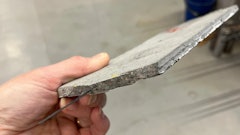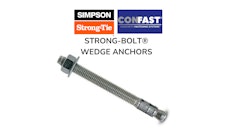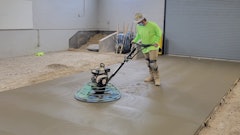Tolerance incompatibility between structural concrete frames and elevators, stairs, cladding, windows and floor coverings often creates jobsite disputes. The crux of the problem: Factory manufactured products with tolerances expressed in hundredths of inches must interface with concrete structural members built to tolerances measured in fractions or whole numbers of inches.
ACI Committee 117 is developing a document titled “Guide for Tolerance Compatibility in Concrete Construction.” It will list standard tolerances for materials and products that interface with concrete construction and include some suggestions for accommodating incompatible tolerances. But in some cases, there isn’t universal agreement on a solution for tolerance incompatibility. Some specifiers’ solutions, however, place a burden on the concrete contractor.
The risk transfer ruse
Consider the following excerpt from a contract document:
“Regardless of the tolerances stated, concrete work shall be coordinated with the work of other trades to be anchored and attached to concrete such that the other work will fit within the tolerances for that work. Provide field measurements of in-place concrete work as required, prior to fabrication of anchored or attached elements, as required.”
This specification clause transfers risk from designers to concrete contractors by requiring them to make interfacing components fit. Even when the concrete components are built within Division 3 tolerances — usually from ACI 117-10 — this risk transfer clause obligates concrete contractors to do any rework needed to fix tolerance incompatibility problems.
To add to the financial burden, the concrete contractor must provide field measurements as required. How do concrete contractors rationally bid jobs with such specification requirements so they can be compensated for their field measurements and needed rework? They can’t, but are expected to.
How did we reach this point in the design-bid-build process?
Why the ruse is now needed
An essay by H. Robert Dinsmore, Jr. describes the original architect as a masterbuilder, skilled in both design and craftsmanship. Yes, architects were expected to be capable of building with their own hands. They were responsible for construction with “…complete and total authority on the building site.”
According to Dinsmore, the masterbuilder disappeared in the 20th century:
“In his place was set up two inventions of the modern age: 1) the architect — responsible for design only, but having no genuine knowledge about how a building is really built, and 2) the general contractor — responsible for construction only, but having no genuine notion about design.”
The terms structural engineer, engineer, designer or design professional could be substituted for “architect” in many cases today.
Because many design professionals have little idea how tolerances for building components must be harmonized, they leave the tolerance setting to component manufacturers. Then, to protect themselves from litigation when mismatched tolerances affect quality, schedule, and cost, their specifications pass the risk to another construction team member.
Alternatives to risk transfer
A solution for this problem is essential. ACI Committee 117’s report on tolerance compatibility is a start. But more is needed, because this document will suggest only some solutions for tolerance compatibility problems.
Well-designed structural connections can solve many tolerance compatibility problems at a cost less than the rework currently required. Grinding and patching floors costs less than requiring extremely flat floors. Better data on the cost of tighter concrete tolerances as compared with the cost of looser would be useful. Engineering, architectural, and construction management students need to better understand how structures are built, and the role played by tolerances.
A workshop with delegates from engineering societies, contractors, and construction managers could be a useful exercise in better defining responsibilities and risk of all construction team members. Transferring the risk to one member is not a viable solution.
Reference
Dinsmore, H. Robert, Jr, “The Ancient Masterbuilder,”, 2008, 5 pp., http://www.masterbuilderfellowship.com/page5.html



























